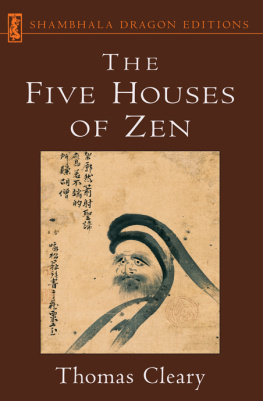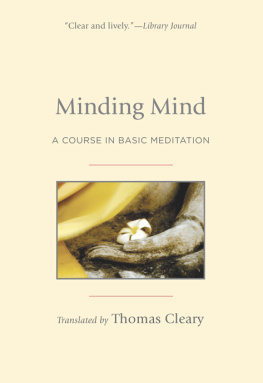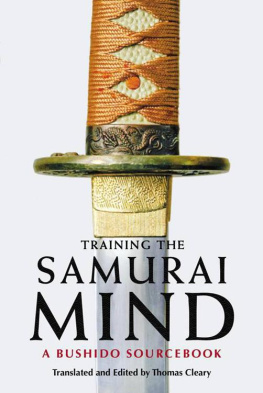Thomas Cleary - Zen Mind, Buddha Mind
Here you can read online Thomas Cleary - Zen Mind, Buddha Mind full text of the book (entire story) in english for free. Download pdf and epub, get meaning, cover and reviews about this ebook. year: 2016, genre: Religion. Description of the work, (preface) as well as reviews are available. Best literature library LitArk.com created for fans of good reading and offers a wide selection of genres:
Romance novel
Science fiction
Adventure
Detective
Science
History
Home and family
Prose
Art
Politics
Computer
Non-fiction
Religion
Business
Children
Humor
Choose a favorite category and find really read worthwhile books. Enjoy immersion in the world of imagination, feel the emotions of the characters or learn something new for yourself, make an fascinating discovery.

- Book:Zen Mind, Buddha Mind
- Author:
- Genre:
- Year:2016
- Rating:4 / 5
- Favourites:Add to favourites
- Your mark:
- 80
- 1
- 2
- 3
- 4
- 5
Zen Mind, Buddha Mind: summary, description and annotation
We offer to read an annotation, description, summary or preface (depends on what the author of the book "Zen Mind, Buddha Mind" wrote himself). If you haven't found the necessary information about the book — write in the comments, we will try to find it.
Zen Mind, Buddha Mind — read online for free the complete book (whole text) full work
Below is the text of the book, divided by pages. System saving the place of the last page read, allows you to conveniently read the book "Zen Mind, Buddha Mind" online for free, without having to search again every time where you left off. Put a bookmark, and you can go to the page where you finished reading at any time.
Font size:
Interval:
Bookmark:
Zen Mind, Buddha Mind
Introduction
Chan Buddhism, ancestor of Zen, was called the school of the mind of Buddha, or the school of the source or the aim. Based on the principle known in Sanskrit as vijnapti-matra, consisting of representation, or citta-matra, consisting of thought, expounded in the seminal scripture Lankavatara-sutra, Chan Buddhists considered the world as experienced and conceived to be a reflection of mental construction, and sought insight into the essence of mind itself, apart from temporal conditioning and artificially inculcated views and interpretations of reality, in order to become mentally free and independent.
The principle of vijnaptimatra or cittamatra has sometimes been confused with a philosophy of idealism, in the case of Chinese Buddhism and its derivatives, in part because Chinese characters used for the Sanskrit words for representation and thought were also used for consciousness and mind. The practical purpose of the principle of vijnaptimatra in the Buddhist context is to facilitate disentanglement from subjective ideas and opinions that form the basis of mental afflictions such as the so-called three poisons of greed, hostility, and folly.
When Chan Buddhism was developing in China, one of its aims was overcoming the influence of such poisons not only in secular life but also in the study of Buddhism, infested as it was by personal ambition, institutionalized dogmatism, and superstitious imagination. In modern times, when the production and marketing of the three poisons have become massive industries and enterprises, the ability to resist these infections has far-reaching potential for liberation of awareness and energy enabling positive evolution in personal, social, economic, political, and religious spheres of interest and activity.
This volume presents translations of teachings of two of the most famous Chan masters in history, known as Huangbo (d. 850) and Linji (d. 867).
According to the earliest compilation of Chan records, Collection from the Halls of the Ancestors, Huangbo left home at an early age and was by nature untrammeled by petty restrictions. He was first enlightened through interaction with a woman he met while begging in the course of his travels; she then directed him to the famous Chan master Baizhang. The later collection of Chan lore Transmission of the Lamp (compiled in) the Jingde Era (1004-1008), which was edited by a Confucian scholar, cuts out the part about his being enlightened by a woman, and the famous Blue Cliff Record casebook says he was enlightened by nature. According to the early record, the woman who first opened Huangbos mind had studied with the National Teacher Huizhong (d. 776), one of the distinguished successors of Huineng, the peerless Sixth Patriarch of Chan.
The teachings attributed to Huangbo, collected in Essentials of the Teaching of Communication of Mind and The Wanling Record, emphasize the immediate individual first-hand experience of the basic mind, apart from acquired habit and second-hand understanding. This is epitomized in a lecture immortalized in the Blue Cliff Record, wherein he scolds his audience, You are all slurping dregs; if you go on like this, where will you have the actuality of Today?
The story of Huangbos famous successor Linji was also considerably redacted. According to the Collection from the Halls of the Ancestors, he went to see the reclusive Chan master Dayu after hearing Huangbo recounting Dayus request to send him a spiritually sharp individual if he should find one. After repeatedly traveling back and forth between Huangbo and Dayu, Linji spent more than ten years in attendance on Dayu, but was formally recognized as a successor of Huangbo. According to the standard story, Huangbo sent Linji to Dayu after rebuffing his questions; then when Dayu told Linji that Huangbo was being kind to him by rebuffing him, trying to relieve him of his burden, Linji was suddenly enlightened.
Linji was noted for his challenging manner of teaching. According to the non-sectarian Biographies of Eminent Monks, his students were erstwhile canonical scholars, and his lectures provide many examples of experiential explanation of scriptural symbolism, while his dialogues illustrate his effort to interrupt indulgence in intellectual rambling and imitative acting, urging people to achieve genuine independence. He cited and followed the admonition of the Lankavatara-sutra that real Buddhism is not a matter of fixed doctrine, but rather expedient means of dissolving sticking points and untying bonds according to individual needs. Biographies of Eminent Monks states that records of his lectures were widely circulated; the stream of Linjis successors and descendants grew to become regarded as a sect of Chan, and the record of his sayings remains a perennial classic.
Essentials of the Teaching of Communication of Mind
The Buddhas and all living beings are just one mind. There is nothing else. This mind, since beginningless time, has never been born and has never died. It is not blue, not yellow; it has no form, no appearance. It is not in the realm of existence or nonexistence. It does not count as new or old. It is not long, not short, not large, not small. It is beyond all limitation, quantification, terminology, tracks, traces, and relations. This very being is it; if you stir thoughts, you turn away. Like space, it has no boundaries and cannot be measured.
Just this one mind is itself Buddha. Buddha and living beings are no different. However, living beings grasp appearances and seek outwardly. By seeking it they lose it: getting Buddha to seek Buddha, using mind to grasp mind, they never can get it in all their lives. They do not know that if they stop thoughts and forget cogitation, Buddha spontaneously becomes manifest.
This mind itself is Buddha; Buddha is living beings. When it is living beings, this mind is not diminished, and when it is Buddha, this mind is not augmented. Even the six ways of transcendence, myriad practices, and countless virtues are originally inherent and not added by cultivation. They are exercised when conditions are meet, and quiescent when conditions cease. If you do not trust with certainty that this is Buddha, and try to cultivate practices fixated on appearances to seek effective application, this is all imagination, contrary to the Way.
This mind is Buddha; there is no separate Buddha, and no separate mind. This mind is clear and pure, like space, with no appearance at all. If you excite the mind and stir thoughts, you turn away from its true essence. This is fixation on appearances, and there has never been a Buddha fixated on appearances. If you cultivate the six ways of transcendence and ten thousand practices seeking to become a Buddha, this is a step by step process, and there has never been a step by step Buddha. Just realize one mind; there is nothing more to be attained. This is the real Buddha.
Buddhas and living beings are one mind, no different, like space, without mixture, without decay. It is like the sun illuminating the world; when the sun rises, light covers the world, while space has not been illumined. When the sun sets, darkness covers the world, yet space has not been darkened. States of light and darkness supersede one another, while the nature of space is empty and unchanging. Buddhas and the mind of living beings are also like this; if you contemplate Buddhas as characterized by purity, light, and liberation, and look upon living beings as characterized by pollution, darkness, and birth and death, those who entertain this understanding will never attain enlightenment, even in countless eons, because they are fixated on descriptions.
It is just this one mind; there is nothing more to attain at all. Mind itself is Buddha. People who study the Way now do not realize the essence of this mind, and so produce mind upon mind, thought upon thought, seeking outwardly to become Buddhas, cultivating practice fixated on forms. This is all wrong; it is not the path to enlightenment.
Next pageFont size:
Interval:
Bookmark:
Similar books «Zen Mind, Buddha Mind»
Look at similar books to Zen Mind, Buddha Mind. We have selected literature similar in name and meaning in the hope of providing readers with more options to find new, interesting, not yet read works.
Discussion, reviews of the book Zen Mind, Buddha Mind and just readers' own opinions. Leave your comments, write what you think about the work, its meaning or the main characters. Specify what exactly you liked and what you didn't like, and why you think so.













